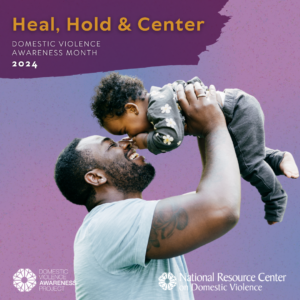Healing: A Key Piece to Preventing Domestic Violence for Future Generations
Authored by Ashleigh-Klein Jimenez
Note: This blog was originally published as part of the National Resource Center on Domestic Violence’s (NRCDV) Domestic Violence Awareness Campaign: Heal, Hold, and Center. Ashleigh joined three other guest writers, exploring what it means to heal, hold and center survivors in our work to end domestic violence.
_____________________________________________________________________________________________________
 October is Domestic Violence Awareness Month, a time to reflect on the critical issues surrounding intimate partner violence and to explore effective strategies for prevention. This year, as we focus on the theme of “Heal, Hold, & Center,” I am continuing to consider how healing can serve as a powerful tool in changing systems and preventing future harms.
October is Domestic Violence Awareness Month, a time to reflect on the critical issues surrounding intimate partner violence and to explore effective strategies for prevention. This year, as we focus on the theme of “Heal, Hold, & Center,” I am continuing to consider how healing can serve as a powerful tool in changing systems and preventing future harms.
Healing is not just a personal journey; it has far-reaching implications for communities and future generations. For those of us who have witnessed or experienced domestic violence, healing can be a transformative process that extends beyond the individual. It can reshape entire family histories and contribute to systemic change.
In my own family, the legacy of violence spans generations. It has been through this personal history, my deep commitment to primary prevention, and listening to women of color who have been advocating for decades that healing is a cornerstone of prevention that my understanding of prevention has become more expansive. Healing isn’t just about addressing past trauma, it’s about creating new pathways and healthier relationships and environments. It’s about addressing the root causes of violence and challenging systems that perpetuate it.
I remember the first time I heard Arlene Vassell of TooREL Institute for Social Change say that healing and prevention are interconnected and having a light bulb moment. To me, healing and prevention are deeply interconnected because the communities disproportionately impacted by intimate partner violence are often those who have also endured legacies of colonization, genocide, slavery, and structural racism. These historical harms leave lasting effects, and to prevent violence, we must address the ongoing trauma communities face. Healing practices, such as reconnecting to culture, community, and self, are vital for prevention because they help create the conditions where people can thrive. This collective well-being is essential for building environments that prevent violence in the first place.
Prevention is not just about stopping harm before it happens; it’s about creating a world where everyone has the opportunity to live fully, free from the cycles of violence and trauma that have persisted for too long. If we commit to healing, we can finally build the foundation for true prevention and collective liberation.
Other Heal, Hold and Center blogs
Week 1 – Heal, Hold & Center in Action: Showing up for Survivors this DVAM and Beyond
Week 2 – Breaking Down Barriers: Healing Trauma in Latin@ Communities
